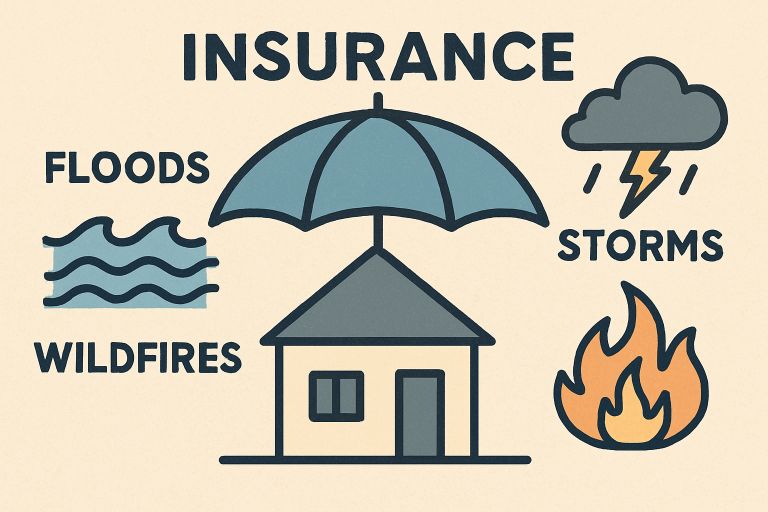Key Takeaways
- Rising natural disaster threats are fundamentally reshaping home insurance markets and premiums nationwide.
- Policy changes and tightening coverage require homeowners to review options and seek supplemental protection when needed diligently.
- New products like parametric insurance offer innovative solutions for fast disaster recovery.
- Investing in disaster-resilient home improvements yields both safety and cost-saving benefits.
- State and community-backed initiatives help ensure continued access to home insurance in high-risk regions.
- Staying informed and proactive is the best defense against today’s dynamic insurance environment.
Table of Contents
- Introduction
- Rising Insurance Premiums
- Policy Adjustments and Coverage Limitations
- Emergence of Parametric Insurance
- Incentives for Disaster-Resilient Construction
- Government and Community Initiatives
- Proactive Measures for Homeowners
Introduction
The landscape of home insurance is undergoing a dramatic transformation as natural disasters grow more frequent, powerful, and unpredictable. Catastrophic events like hurricanes, wildfires, floods, and even hailstorms allow insurers and property owners to address risks in new ways. The industry is responding by introducing innovative policies, modifying coverage terms, and increasing rates at an unprecedented pace. For homeowners, staying knowledgeable about these shifts is more important than ever. Exploring options such as AAA home insurance quotes can provide invaluable insight into how present-day risks affect the insurance market and what protection strategies are available.
Traditional home insurance options are being recalibrated in response to mounting threats. Those who own property, especially in areas prone to severe weather, or track market developments, thoroughly review available policy features and limitations. The implications of these industry changes are wide-ranging, influencing not only the cost of insurance but also the ease of obtaining adequate coverage. For many, this new era means reevaluating not just insurance strategies, but long-term choices about homeownership itself.
Rising Insurance Premiums
Premiums for home insurance are escalating rapidly, particularly in regions at risk for natural disasters. Recent industry reports reveal that between 2018 and 2022, homeowners in disaster-prone zones paid an average premium of $2,321 per year, compared to $1,277 for residents in less vulnerable locales. This considerable price gap reflects how insurers calculate risk and their determination to protect themselves financially against the growing cost of claims. These ever-burdensome premiums can burden families financially, affecting monthly budgets and sometimes forcing difficult decisions, such as reducing coverage levels or relocating to less hazardous areas.
Beyond rising costs, many homeowners in high-risk areas find coverage harder to secure. Insurance companies, faced with mounting payouts and volatile claims, are downsizing or withdrawing from these markets entirely, leaving consumers struggling to find adequate policies. In such environments, comparing rates and coverage is a vital first step in determining which insurer best meets your needs, both in terms of protection and affordability. Keeping pace with market trends and premium hikes is crucial for maintaining coverage for your home and assets.
Policy Adjustments and Coverage Limitations
To respond to mounting claims and unpredictable threats, insurers are reshaping standards significantly. Key trends include:
- Exclusions for Specific Perils: A growing number of policies exclude major threats such as wildfires, floods, and earthquakes from coverage. This leaves homeowners in a position where they must purchase specialized disaster insurance separately, which can add to the complexity and cost of comprehensive protection.
- Higher Deductibles: Many policies now stipulate much larger deductibles for claims resulting from catastrophic events. This shift transfers a greater share of financial responsibility onto the homeowner, who must be prepared to pay more out-of-pocket if disaster strikes.
- Non-Renewals: Insurers in high-risk regions often refuse to renew existing policies, forcing residents to seek alternatives. This trend can disrupt planning and leave property owners scrambling for limited options, such as state-sponsored last-resort insurance pools.
The lesson for homeowners is clear: regular, careful review of policy documents is essential. Understanding and defining precisely what is and is not covered—down to every exclusion and special deductible—is crucial to avoid expensive lapses in protection after an event. Purchasing updated documentation can minimize unwelcome surprises and help homeowners bounce back more easily from a loss.
Emergence of Parametric Insurance
One of the most notable innovations in the insurance industry is the growing popularity of parametric insurance, especially in areas frequently hit by severe disasters. Unlike traditional insurance, which reimburses the exact cost of damage after an assessment, parametric policies promise a predetermined payment if specific “triggers” are met, such as an earthquake exceeding a certain magnitude or a hurricane hitting a particular wind speed. As a result, claims are processed and paid out rapidly, without waiting for lengthy inspections or documentation procedures.
This speed is a lifeline for homeowners needing immediate help to pay for repairs, temporary relocation, or emergency supplies. Parametric coverage can fill key gaps, particularly in high-risk zones where regular insurance may be limited or slow to respond. While this form of insurance is still evolving and not as widespread as conventional products, the demand for quick, reliable payouts is fueling its expansion, making it a powerful addition to the modern home insurance toolkit.
Incentives for Disaster-Resilient Construction
The structural resilience of homes is an effective way to reduce both risks and insurance costs. Data from a notable Alabama study shows that houses built to Fortified standards experience 55-74% fewer insurance claims and damages, and when claims occur, the damages are 14-40% less severe compared to traditionally built homes. Recognizing the positive impact of disaster-resistant design, more insurers offer premium discounts, expanded coverage, or other incentives to homeowners who proactively invest in resilience efforts.
Simple strategies—such as installing storm shutters, using impact-resistant roofing, creating defensible landscapes to deter wildfires, or adding flood barriers—can dramatically reduce the likelihood or severity of losses. These upgrades provide immediate safety benefits and make homes more desirable to insurers, who are eager to minimize their risk exposure. The up-front investment in disaster-resilient construction can pay for itself in lower premiums and greater peace of mind over the long term.
Government and Community Initiatives
As private insurers retreat from the most disaster-exposed regions, state, local, and community-based programs are beginning to fill the gaps to ensure residents are not left without protection. Some notable efforts include:
- State-Backed Insurance Programs: In particularly challenging areas—such as fire-prone California or hurricane-hit coastal zones—state-sponsored policies like the California FAIR Plan provide basic property protection when private insurers withdraw from the market.
- Community Risk Pools: Local groups sometimes band together to collectively fund insurance pools, distributing risk across a large base of participants. This cooperation can keep costs more reasonable and ensure broader access when private policies are no longer viable.
These public solutions are designed as safety nets, helping residents maintain property coverage in volatile environments. For those interested in further details or real-time updates on industry trends and disaster insurance, the Insurance Information Institute is an excellent resource for guidance, statistics, and the latest industry news.
Proactive Measures for Homeowners
Navigating the modern insurance landscape demands an active approach. Homeowners should consider several key strategies to enhance their resilience and ensure adequate protection in a changing world:
- Review and Update Policies: Conduct annual insurance checkups and speak with licensed agents to ensure coverage is current and to complete any changes to the policy or local risk factors.
- Implement Mitigation Strategies: Invest in upgrades like strengthened roofs, storm shutters, elevated wiring, and defensible landscape improvements to bolster property value and often qualify for insurance savings and policy enhancements.
- Stay Informed: Remain vigilant regarding emerging local risks and industry trends by consulting professionals, tracking news, and using reliable online resources. Staying current with the latest developments leads to more intelligent choices and less exposure to unforeseen gaps in protection.
By embracing preventative measures, families are better prepared to minimize losses, negotiate favorable terms, and recover more quickly in the aftermath of disasters. This protects assets and provides vital confidence and peace of mind during uncertain times.



